

|
Home Updates Hydros Cars Engines Contacts Links Contact On The Wire |
On The Wire in
New Zealand
Brayshaw Park,
Blenheim
Knowing our involvement with OTW, our friends keep a weather eye out for anything that might be of interest for the website. My mechanic from the days of hydroplane racing and his wife have a wonderful ability to root out the unusual, and have come up with some amazing material in the course of their travels. Among the more surreal were a lovely pair of very elderly brothers who owned an unlimited hydroplane, that ‘they took for a run on the river occasionally’. As well as the boat, they had a container lorry full of Rolls Royce Merlin engines, including a couple that had become V6s by the simple expedient of taking a hacksaw to the block and internals. Cries of anguish emanate from around the world at this news! On another trip they found what has to be the most comprehensive spark plug collection anywhere. It was a visit to the Marlborough wine-growing region of New Zealand that turned up this ‘corker’, although it took a couple of years and a return visit to unravel the mystery. Even then, there was another remarkable twist to the tale.
They were wandering around a local heritage centre on the outskirts of the town of Blenheim when they saw a pond with a pole stuck in the middle, which they thought might be something to do with tethered boats. Having returned to their holiday base, they asked a friend in the locality to take some photos, which he duly did, all of model yachts sailing on the pond, with insufficient detail to come to any conclusions.
|
|
A year went by before they could return to the area, and this time they were armed with video and still cameras to record everything they could see. A close up of the ‘pole’ emailed to me confirmed that it was a pylon, so this had definitely been used for tethered boats at some stage. A search of the internet showed that there had been tethered records set up to the late 1970s in New Zealand, but it was assumed that this might have been at Dunedin as there were no further details. After photographing everything that might be of use for an article, George and Jackie peered over a nearby fence, only to find a tethered car track as well. This was getting more interesting by the minute, but we were blissfully unaware of this latest development until they arrived back in England with all the evidence. |
|
Piecing together all the information they had gathered, it seemed that the pond and track were near the airport and part of the local museum. Enquiries in the museum had gleaned a contact name that might be of some help, and with this there seemed enough material to be able to do some more detailed research. The museum and airport soon led to the name Brayshaw Park, and a quick search on Google Earth revealed the complex with the pond and track. Easy of course, once you know where to look, as it is not where Google says it is. Having this to hand I had enough information to email the contact, and ask some sensible questions. |
|
Ron Perkinson’s reply filled in most of the details for me.
"Brayshaw Park was established back in the 1960's, on ground that was previously the old rubbish dump. I joined the club in the early 80's. At that time the present figure 8 shaped raised train track for 2½, 3½, and 5-inch gauges was under construction. There was a flying circle for control line aircraft and the boat pond was also there. The flying circle is now no longer as other buildings have been erected and a ground level 5 and 7¼-inch gauge railway constructed. Since my time in the club the boat pond has only ever been used for yachting and scale model boating, and is very much still in use for this purpose today. I have never seen tethered power boats in use on the pond although the centre pole is still there. The tethered car track was constructed in the mid to late 80's, mainly by one of the club members who had shifted to this area and was mad keen on making and running the cars. Ken McIntyre is the members name and he still makes and operates the cars, but normally only on full open days in the park, maybe 2 or 3 times a year. He ran the cars last on 7th Feb this year (2010)."
Brayshaw Park was created in 1968 to house the vast collection of agricultural machinery and equipment that had been collected by Norm Brayshaw, a local chemist. He was considered something of a visionary as he could see the agricultural heritage of the country being lost to future generations. The 12 acre site was gifted by the local council and now hosts five different organisations, including the modellers.
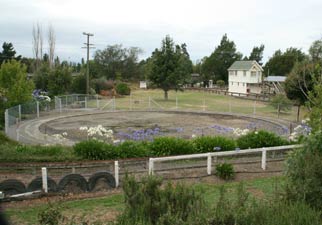 |
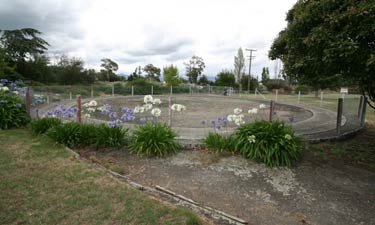 |
Ron very kindly passed on my request for information to Ken McIntyre who forwarded this fascinating account of activities in New Zealand
From Ken McIntyre, Blenheim, New Zealand
"I am a Life Member of both the Marlborough Associated Modellers, Blenheim, and the Otago Model Engineering Society, Dunedin. These two Clubs have the only Pylon Car Tracks in New Zealand. On both tracks, 6 laps = 1/4 mile. The Dunedin track was established about 1950-1952 and the Blenheim track in the late 1980s when I shifted to Blenheim.
 |
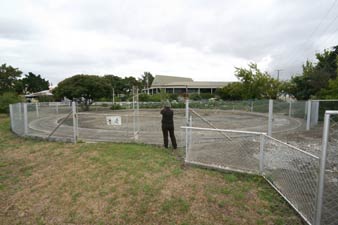 |
In the 1950s there was a strong group of members in the Dunedin Club, about ten I think, who built and operated a range of Pylon cars which included a factory Dooling 6 car, a Nordec car, a range of cars powered by a Swiss Amro 60, Nordec 10ccs and home built 10cc Hornet engines. There was a range of smaller cars, Oliver Tiger twin shaft 2½ diesel, McCoy 3½ Planetary geared Offenhauser type as well as quite a few home made cars.
The larger cars were mainly spark ignition powered and the smaller mainly diesel powered (tough on tyres when they stopped due to compression lock up). For years the member with the Dooling car dominated the club as it was guaranteed to do 100 + mph. About early 1952/3 the Model Maker magazine published a series of articles on Ian Moore's record breaker 10cc car No 12 and a series on building his 5cc speed model. Some of us younger members decided to build both these cars and with tuning of engines, gearing and tyres were able to achieve 100 mph+ speeds. There is still a strong following in the Dunedin club, after a decline of some 30 years. I am the only member in Blenheim who has an interest in Pylon cars and I travel to Dunedin to run my cars there. I only run cars in Blenheim at displays.
I have a large stable of operating cars, consisting of 8 based on Ian Moore's No 12 design. Engine sizes, gear box ratios and tyres vary. My earliest cars still operating are one with 10cc Nordec, built 1956, speed 90 mph; a 2½ cc Supertigre powered Italian Movosprint 52; 2000 Ferrari. Some of my other No 12 cars range from 2½ cc to 10cc. The 2½ cc car is capable of 60 mph.
My mid range cars are powered with a range of OS 35 & 40 engines and generally run in the 90 - 115 mph bracket. My top 10cc car was built in 1976, powered by a modified Rossi 60 speed engine and is capable of hitting 200 mph. My last car is a scale 1963 Chevy Corvette Coupe powered with a McCoy 29. This car is very heavy but can achieve 60 mph. Sadly my Tiger twin shaft car and McCoy Offenhauser expired many years ago although I still have an Oliver Alfa Romeo body and front axle complete. I still retain the patterns for the aluminium pans, fibreglass bodies and gearbox castings for the No 12 cars. I built my own gear sets and have made the moulds to manufacture the tyres for all my cars."
This was a remarkably detailed account, but I was still intrigued by the hydro lake and a series of spillways and slipways that I could not see the reason for. My enquiry elicited the following from Ken.
Regarding the pond at Brayshaw Park, Blenheim
 |
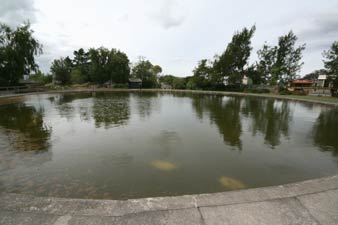 |
"In the years 1950 to 1975 Control Line (tethered) boats were run in the pond. The centre mounting is still in place and these days when radio controlled boats are run, a dummy lighthouse is fitted over the centre pole.
|
What you can see on Google Earth is not a spillway but a short canal between the pool and the boat harbour with three wharfs. This set up allows both electric and IC powered boats to operate. Having the boat harbour permanently set up is an integral part of steering and docking events. Having the boat harbour is much easier to launch boats in than putting them in around the pool. The pool is deep enough to sail large yachts and the boat harbour has 12 inches of water, deep enough to float the biggest of models." |
|
All this tells the story of a second purpose built model complex on the South Island of New Zealand with facilities for tethered cars and hydro’s representing a very rich history in these two disciplines. To complete this article, it would be wonderful to make contact with anyone who ran a tethered hydroplane at Brayshaw Park. Does anyone have any details of the records set in the 1970s or photographs of tethered hydroplane activity in New Zealand? Any further information would be greatly appreciated.
My thanks go to George and Jackie Penny for setting this whole project in motion and providing all the photos of the Brayshaw Park complex. Sincere thanks go to Ron Perkinson and Ken and Fione McIntyre for their very detailed and informative replies to my enquiries.
©copyrightOTW2011
|
Empty Spaces. May
2017: Ken McIntyre |
|
In recent years he got onto some long planned but never undertaken projects - 1/4 scale 1905 Gnome rotary engine from plans, 8 or 9 Stirling hot air engines of varying designs from plans, Tesla turbine from plans. He was always interested in different engineering activities. His final Stirling was completed only a matter of weeks before he couldn't use his workshop any more. He made up a gantry so he could swing chucks on and off the lathe as he became too weak to lift them.
There was another car track in NZ, and Dad also built that one. We lived in a small town - Otematata - in North Otago, as Dad worked at and later ran Benmore Power Station. After construction ceased, there were a few large building floor pads left just outside the power station. Dad drilled a hole in one and cemented in a pole - instant track, as the concrete was very smooth and flat, so he could build and test cars before showing them to the public in Dunedin. I do remember that we warmed up the cars inside at Dunedin using the lathe chuck as a wheel! Used to cause a stir when un unmuffled car engine fired up. Then it was out to the track and run the car.
Update Sept 2017:- I finally located a reasonable photo of all Dads cars - dated 1996, taken at Blenheim.
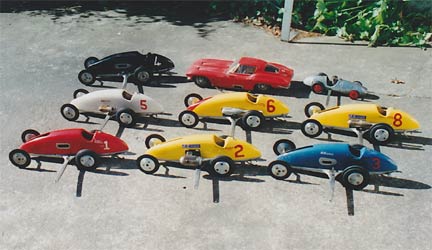 |
 |
In the back row L - R No4. Ian Moore No 12 car, with 10cc Nordec motor. This is the car that he alluded to in his original article (see above), his first Ian Moore car.
Next is the 1963 Chevrolet Corvette. It has a McCoy 10cc motor. The Corvette could be run with the body on, as the back window was removable. But the few times that it was run, was usually in chassis form only. It has the old style cable tether rather than a panhandle. Then the Movosport Ferrari with 3.5cc Supertigre engine Middle row are the same Ian Moore design cars, with various OS engines. Nice and easy to run, and quieter too for the watching public.
Front row is the Red Rossi Speed 60
10cc car - his fastest car by a long way, then two more OS engined cars. The
OS cars were assembled from a couple of old cars that had no engines, and
some from new unused pans and bodies. At the time they originally made these
cars, they cast up quite a few pans and gearbox housings, and made a few
fibreglass bodies.
Tyres were all home-made. Dad made up the moulds and he used re-treading
rubber. A gas torch heated up the moulds and a press was used to compress
the mould halves and centre. 9 out of 10 came out perfect. The rear tyres
are hollow, so at speed grow bigger. When he built the Rossi car he started
blowing tyres, so had to machine down the centre mould insert to make the
tyres slightly thicker. This solved the blow outs, and they still expand at
high speed, which I guess gives variable gearing.
The Dooling 10cc car is no longer here, and it may have been the car that
snapped the tether at full speed and went into a concrete post.
Unfortunately I didn't think to try and get all the car history until it was
too late.
I am in the process of trying to
rebuild the Oliver Twinshaft Alfa that Dad also had. At present it is just
the body, front axle and wheels.
Dad sold the 5 OS cars to Chris Kennedy in Dunedin, when he got sick, and
Chris continues to run them, along with his modern cars, which is great to
see.
Thanks to David McIntyre for these photos and all the additional material
Otago Model Engineering Society
 |
 |
The car track is one of two left in New Zealand, the other being in Blenheim (see above). The track was built around 1951–1952 at the club grounds. At the height of its time there were around 10 members running cars of all types then dropping to two members until around 12 years ago, when one of the younger members Chris Kennedy got interested in the cars after watching Ken McIntyre, one of our yearly runners.
Ken McIntyre joined the club in 1953 just after the track was made at the age of 16. His first car was a home built special running a ED Racer diesel, most of the parts being made at home, the inside back wheel being the driving wheel. The top speed of the car was 30 mph. Ken has been running cars ever since, here in Dunedin or at his home base in Blenheim. Ken has 9 running cars at the moment ranging from 2.5cc to 10cc. His most famous car is his 10cc Rossi 60, which every one at the club has nicknamed 'the red car'. Built in 1976, the car has been running at our festival week just about every year. Its top speed in 2009 was 108 mph. Ken has stated that the car will go faster but at the same time it could possibly destroy its self. Being a classic, it’s best just the way it is.
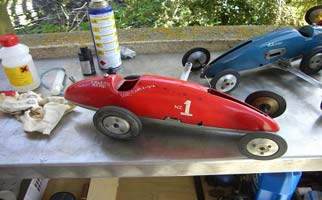 |
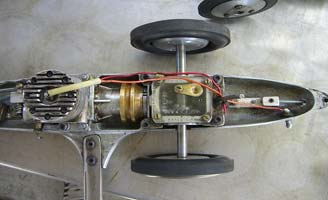 |
| Ken McIntyre's 'Red Car' | Motor and gearbox of Ken's 'Red Car' |
The boat pond was rebuilt in the early 60's with an a split bottom with a few add-ons over the years. There’s never been that many members running hydro’s on the pond over the years, with the most at one time being 4 running 10cc boats in late 60's early 70's. Gary built his first airscrew hydro in 1972 called ‘Skip It’, running a 2.5cc Taipan. He then built ‘Skip It 2’ in 1976, still running a 2.5cc Taipan. ‘Skip It 2’ lasted until 1980 when it blew itself to bits at high speed. It was then rebuilt with some changes until about 8 years later when it once again fell on misfortune when a R/C boat went into its path, causing a big crash at speed to the great delight of the crowd watching. Dad was not a happy man, as his boat ended up in four pieces while the other boat had nothing but a small scratch. Dad had hit him square on the beam. The boat was once again rebuilt and is still going today.
 |
 |
 |
|
Andrew and Gary Douglas with airscrew hydros on the boat pond |
||
Well I hope that gives a wee bit of information of what we get up to in the deep south. As you can see, we’re still going strong and hope to keep it that way.
If you would like more information about the club you can go to our club
web page at
www.omes.org.nz or the club President Andrew Harbrow +64 34543169 email
aaharbrow@farmside.co.nz
Boat group leader Gary Douglas +64 34767311
A.DOUGLAS1@xtra.co.nz
Car group leader Mel Kennady +64 34667372
©copyrightAndrewDouglas&OTW2009